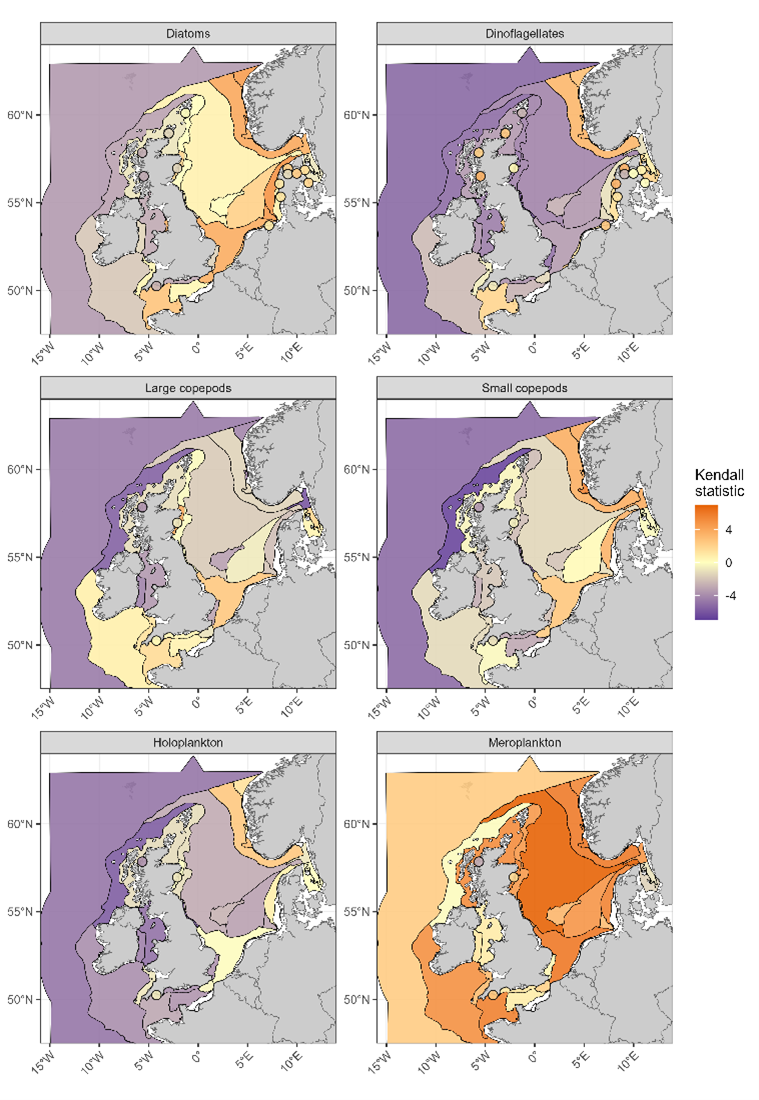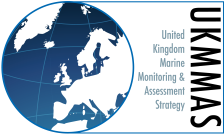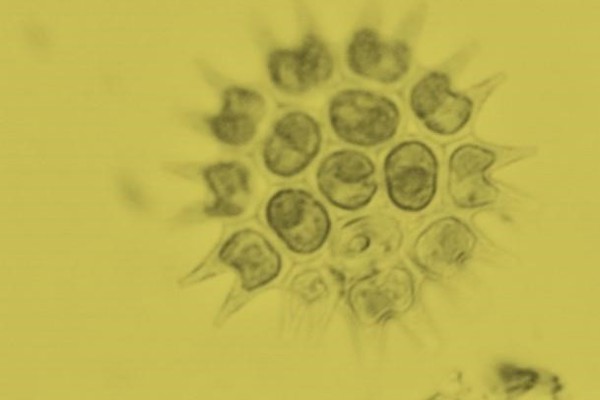Pelagic habitats
The extent to which Good Environmental Status has been achieved
There have been important changes in biomass, balance of organisms, and diversity of plankton since the 1960s. It is difficult to determine what the direct implications of these changes will be for pelagic habitats and the associated trophic relationships and food web dynamics in the Greater North Sea and Celtic Seas. In the absence of a suitable model for Good Environmental Status (GES), it is currently not possible to determine if pelagic habitats are in GES, however, all currently available evidence suggests that pelagic habitats in both the Greater North Sea and the Celtic Seas are in “Not good” status.
Progress since previous assessments
The 2019 UK Marine Strategy (UKMS) assessment found that plankton communities in the Greater North Sea and Celtic Seas were experiencing changes in biomass, abundance, and community structure, and determined that the GES of pelagic habitats was “Uncertain”, since the assessment methodology at the time did not support linking to environmental pressures. It was determined that prevailing oceanographic and climatic conditions were likely driving these changes. Improvements to the methodology for the 2024 assessment have supported the ability to link these trends more definitively to anthropogenic and environmental pressures.
Climate change and its effects on increased sea temperature and stratification are almost certainly impacting pelagic habitats. Further, interventions to reduce nutrient input from anthropogenic sources have been more effective at reducing phosphorus than nitrogen, generating an imbalance and increasing the vulnerability of pelagic habitats to land based nutrient pollution. Under imbalanced conditions, influxes of nutrients due to increased precipitation and riverine input are more likely to trigger blooms and eutrophication events (Figure 1).

Figure 1. Coccolithophore bloom (light blue) observed from Copernicus Sentinel 2B satellite data in 2020. Image processed at Plymouth Marine Laboratory by the NERC Earth Observation Data Acquisition and Analysis Service (NEODAAS). Image credit: Daniel Clewley.
How progress has been assessed
Assessment overview
Pelagic habitats in the Greater North Sea and Celtic Seas have experienced widespread changes over the past 60 years, due to anthropogenic pressures, including changes in nutrients, climate change, as well as natural climatic cycles. The pelagic habitats assessment focuses on the past 60 years due to the temporal extent of plankton monitoring time-series. While offshore areas were extensively surveyed from 1960 by the Continuous Plankton Recorder (CPR) programme, coastal areas and river plumes had shorter time-series, typically commencing between 1980 and 2000.
The two indicators in Table 1, were developed in collaboration with the Convention for the Protection of the Marine Environment of the North-East Atlantic (OSPAR) contracting parties to inform the latest Quality Status Report (QSR) 2023.
Both indicators have been adopted to carry out a regional assessment for UK waters by our scientific experts. Sufficient spatial and temporal confidence among plankton time-series and high consistency among indicator results were required before GES could be determined. When these requirements were not met, status was designated “Unknown”.
Table 1 sets out the criteria and its associated targets and relevant indicators that were used to assess progress toward meeting GES for D1 Pelagic Habitats. For each, we set out whether it has been met, not met or been partially met across both UK sub regions. We have also linked to the corresponding OSPAR Quality Status Report (QSR) 2023 Common Indicators.
Table 1. Summary overview of the status for all pelagic habitat assessments.
|
Criteria 1 |
Habitat distribution and condition |
|
2019 Target |
The structure, function, composition, and abundance of the plankton community is not significantly adversely influenced by anthropogenic drivers. |
|
Corresponding OSPAR QSR 2023 Common Indicator |
Changes in Phytoplankton and Zooplankton communities |
|
Greater North Sea |
Not met |
|
Celtic Seas |
Not met |
|
Corresponding OSPAR QSR 2023 Common Indicator |
Change in plankton biomass and abundance |
|
Greater North Sea |
Not met |
|
Celtic Seas |
Not met |
Detailed assessments
Indicator assessments revealed a general pattern of decreasing zooplankton abundance and decreasing phytoplankton abundance and biomass across the Greater North Sea and Celtic Seas (Figure 2).

Figure 2. Indicator results (PH1/FW5 - changes in plankton communities, PH2 - changes in plankton biomass and / or abundance) for pelagic habitat types (variable salinity, coastal, shelf) within the Greater North Sea and Celtic Seas. Oceanic / beyond shelf habitats are uncommon within these two regions and were therefore not assessed. This graphic has been designed to follow the format outlined in McQuatters-Gollop et al. (2022).
For the pelagic habitats biodiversity indicators there was variability among indicators, pelagic habitat types, and regions. Icons have been coloured according to indicator status. Current integration methods for pelagic habitats do not allow for the determination of “Good” status.
Strong links between changes in pelagic habitats and rising sea temperature suggest accelerated, human-induced climate change is likely the most significant pressure on plankton, generating potential consequences for food webs and fisheries over the long term. Changing nutrient concentrations and abundances are also impacting the phytoplankton community, particularly in the southern North Sea, as nutrient loadings decrease due to management actions and the relative concentration of nutrients becomes imbalanced due to more successful reductions for phosphorus than for nitrogen (van Beusekom et al., 2009) (Eutrophication assessment.)
Sufficient spatial and temporal confidence among plankton time-series and high consistency among indicator results were required before GES could be determined. When these requirements were not met, status was designated “Unknown”. Pelagic habitats indicator results were integrated for each of the three pelagic habitat types (variable salinity, coastal, shelf) found within the Greater North Sea and the Celtic Seas, based on the majority GES result for each indicator. These summary results were further integrated to produce a summary GES result for the Greater North Sea and Celtic Seas overall, by applying the same majority rules to the GES results for each pelagic habitat type.
Achievement of targets and indicators used to assess progress in 2024
Drivers, activities and pressures affecting the state of the marine environment
All social and economic drivers can potentially influence the quality status of pelagic habitats. Human population growth and its generated demand for food production, waste disposal, coastal development, and energy systems makes it the most significant driver.
Human activities with the potential to directly affect pelagic habitats within UK territorial waters include agriculture, waste treatment, dredging, shipping, fisheries, aquaculture, energy generation, and offshore extraction of oil and gas, many of which contribute to human-induced climate change, nutrient and chemical inputs. Activities associated with the most significant direct pressures include agriculture and waste treatment, shipping, and the impact of climate change on summer stratification, leading to nutrient depletion.
Major pressures affecting pelagic habitats include human-induced climate change and ocean acidification, nutrient and organic enrichment, chemical contaminants, and non-indigenous species. While there is currently insufficient data to describe trends in pressures specifically in the context of pelagic habitats or marine regions, trends in the scale of human activities exerting the above-mentioned pressures may provide a suitable proxy for trends in the pressures themselves.
Impact of pressure on ecosystem services
The provision of most marine ecosystem services is intrinsically linked to the dynamics of pelagic habitats. The holistic nature of the interactions between physical and biological systems that characterise pelagic habitats means that adverse changes in pelagic habitat characteristics can affect the provision of ecosystem services to the entire marine ecosystem.
There is evidence that warming and increased stratification due to climate change have led to widespread declines in key phytoplankton and their crustacean grazers, which are valuable food for fish. Plankton taxa that have increased in their place are unlikely to provide the same value to support fisheries (Schmidt et al., 2020).
Impacts of climate change on pressures and state
General climate change is almost certainly affecting pelagic habitats in the Greater North Sea and Celtic Seas. Both pelagic habitats indicator assessments found strong links between changes in plankton communities and plankton abundance/biomass with upward trends in sea temperature.
The Greater North Sea and Celtic Seas are currently experiencing increasing sea surface temperature due to climate change and decreasing pH due to ocean acidification. Elevated sea surface temperature enhances stratification, causing greater summer nutrient-depletion, and shifting the foundation of pelagic food webs towards a less desirable state, more dominated by small cells which contribute to longer food chains and less efficient transfer to fish. Rising temperatures also drive northward trajectories in the distribution of plankton taxa, many of which are adapted to a narrow temperature range. Many regions are seeing reductions in the abundance of common cold-adapted taxa unable to tolerate warmer temperatures, while previously uncommon warm-adapted taxa are moving in from the Atlantic.
The “textbook” food chain in Figure 3. from diatoms to copepods to fish is illustrated on the right. Current evidence suggests we are moving away from this to alternative pathways on the left of the figure. The grey funnels signify that in these alternative food chains, the larger number of trophic steps and/or the base of the food web being smaller sized, sometimes lower quality food yields less efficient energy transfer to higher trophic levels.

Figure 3. Examples of pelagic food chains from primary producers to fish that may emerge from warming, increase in stratification, and nutrient stress/imbalance. Plankton images courtesy of the Integration and Application Network, University of Maryland Center for Environmental Science (https://ian.umces.edu/media-library/symbols/). Figure adapted from McQuatters-Gollop et al. (2024).
Biodiversity indicators revealed that changes in sea surface temperature from 1960 to 2019 were linked to widespread declines in phytoplankton abundance/biomass. Rising temperatures were also linked to increasing meroplankton and decreasing copepod abundance throughout the Greater North Sea.
Global efforts to slow climate change will likely be the best mechanism to counter widespread changes in plankton communities (Figure 4). Regionally targeted management measures will probably only generate noticeable impact in coastal areas but may have some effect in areas where plankton communities are affected by cumulative impacts of multiple pressures (i.e. warming and eutrophication).

Figure 4. PH1/FW5 indicator results, which show the direction of trends in the abundance of 6 plankton functional groups, or “lifeforms”, between 1960 and 2019. Sea areas are coloured according to the results of the Kendall trend test which indicates how consistent the increase or decrease in abundance has been. Fixed point stations are represented by filled circles. Figure adapted from Holland et al. (2023).
Management actions taken
The actions we are taking to achieve GES for Pelagic Habitats are set out in the UK Marine Strategy Part 3 2025: Programme of Measures.
Climate change remains the most significant factor affecting the health of plankton communities in the Greater North Sea and Celtic Seas. Although the UK has defined targets to reduce its contribution to climate change, widespread international response is necessary.
Other significant human activities and pressures include nutrient inputs, shipping, pollution/waste discharge, and fisheries. Addressing them is within the remit of the UK, most significant being the input of nutrients at a local scale. Improving the state of pelagic habitats will require the UK to work with European nations and relevant organisations to further reduce nutrient inputs to the marine environment, improve ecosystem resilience to climate change and safeguard the shared marine environment.
Next steps
Evidence challenges
There remain important challenges in reducing pressures on pelagic habitats and in understanding the impacts of these interventions:
-
Researching what constitutes conditions not adversely impacted by human activities, so that improved status relative to previous assessments can be detected.
-
Improving our understanding of how changes in the plankton community are linked to pressures in the marine environment.
-
Optimisation of all pelagic datasets (establishment of a working group, quality assurance and quality control of data sampling, data management and maintenance)
Operational objectives
Outside of formal measures to help us continue progress toward meeting GES, the following operational activities will be undertaken:
-
Developing measures to reduce levels of nitrogen as well as phosphorous, resulting from influxes driven by increased precipitation and associated riverine inputs.
-
Better understand and quantify the effects of the key anthropogenic and natural pressures on pelagic habitats; and
-
Further develop and test regional assessment methods at OSPAR level which can then be used in the future for assessing the status of pelagic habitats.
Technical Detail: Good Environmental Status for the next cycle
Table 2. shows the overarching targets (characteristics) for GES, along with their criteria, individual GES targets and associated indicators for the next assessment cycle (subject to change following the UK Marine Strategy Part 1 public consultation).
Table 2. GES criteria and targets for next assessment cycle.
|
Overarching target |
||||||||
|
The structure, function, composition, and abundance of the plankton community is not significantly adversely influenced by anthropogenic drivers. |
||||||||
|
Criteria |
2024-2030 GES targets |
Comment |
Indicators to be used |
|||||
|
Habitat distribution and condition |
The structure, function, composition, and abundance of the plankton community is not significantly adversely influenced by anthropogenic drivers. |
Combined targets for distribution and condition |
|
|||||
References
Holland, M. M., A. Louchart, L. F. Artigas, C. Ostle, A. Atkinson, I. Rombouts, C. A. Graves, M. Devlin, B. Heyden, M. Machairopoulou, E. Bresnan, J. Schilder, H. H. Jakobsen, H. Lloyd-Hartley, P. Tett, M. Best, E. Goberville and A. McQuatters-Gollop (2023). "Major declines in NE Atlantic plankton contrast with more stable populations in the rapidly warming North Sea." Science of The Total Environment: 165505.
McQuatters-Gollop, A., L. Guérin, N. L. Arroyo, A. Aubert, L. F. Artigas, J. Bedford, E. Corcoran, V. Dierschke, S. A. M. Elliott, S. C. V. Geelhoed, A. Gilles, J. M. González-Irusta, J. Haelters, M. Johansen, F, C. P. Lynam, N. Niquil, B. Meakins, I. Mitchell, B. Padegimas, R. Pesch, I. Preciado, I. Rombouts, G. Safi, P. Schmitt, U. Schückel, A. Serrano, P. Stebbing, A and C. Vina-Herbon (2022). "Assessing the state of marine biodiversity in the Northeast Atlantic." Ecological Indicators 141: 109148
McQuatters-Gollop, A., R. F. Stern, A. Atkinson, M. Best, E. Bresnan, V. Creach, M. Devlin, M. Holland, C. Ostle, K. Schmidt, L. Sheppard, G. Tarran, E. M. S. Woodward and P. Tett (2024). "The silent majority: pico- and nanoplankton as ecosystem health indicators for marine policy." Ecological Indicators 159: 111650.
OSPAR (2023). Pelagic Habitats Thematic Assessment. In: OSPAR, 2023: Quality Status Report 2023. OSPAR Commission, London. Available at: https://oap.ospar.org/en/ospar-assessments/quality-status-reports/qsr-2023/thematic-assessments/pelagic-habitats/
Schmidt, K., Birchill, A. J., Atkinson, A., Brewin, R. J., Clark, J. R., Hickman, A. E., Johns, D. G., Lohan, M. C., Milne, A., & Pardo, S. (2020). Increasing picocyanobacteria success in shelf waters contributes to long‐term food web degradation. Global Change Biology, 26(10), 5574-5587.
van Beusekom, J. E., Loebl, M., & Martens, P. (2009). Distant riverine nutrient supply and local temperature drive the long-term phytoplankton development in a temperate coastal basin. Journal of Sea Research, 61(1-2), 26-33.
Contributors
Abigail McQuatters-Gollop and Matthew Holland
Acknowledgements: Arnaud Louchart, Luis Felipe Artigas, Angus Atkinson, Eileen Bresnan, Michelle Devlin, Rowena Stern, Sophie Pitois, Glen Tarran, Hannah Lloyd-Hartley, Paul Tett, Mike Best
Supported by: BDC, ICG-QSR, ICE-Eut, ICG-EcoC, ICG-ESA, CCEG and OSPAR Secretariat


